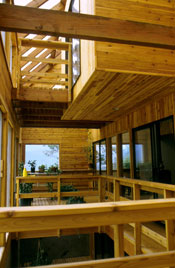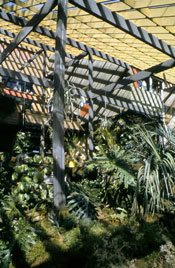the ekose'a home
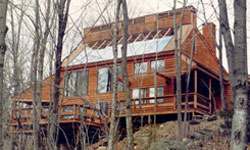

The protective double shell construction and air envelope in contact with the earth are the fundamental components of Ekose'a Homes. The advantages of this house go far beyond the basic criteria for utility-free maintenance of year round comfort. Health, aesthetic qualities, construction and costs are equally important considerations.
health and comfort
In order to better understand how the house works, it is necessary to understand some of the factors that affect human health and comfort.
winter
Conventional houses attempt to control primarily the air temperature. While this is important, the reader is probably well aware that it is possible to feel cold even though the thermostat may indicate that the air is warm. It is important to remember then, that temperature itself is not a measure of comfort. In fact, improvement in the following conditions makes it possible to feel comfortable at temperatures lower than what we are usually accustomed to.
- Radiation of Body Heat – In the conventional house the cold exterior walls, windows and other surfaces absorb body heat and contribute to discomfort. By isolating these surfaces from the climate extremes and surrounding them with earth-heated air, they are able to maintain higher temperatures and thereby improve body comfort.
- Drafts – These same cold surfaces cause drafts of cool air to circulate within each room. As this air moves across the skin of the body it produces a cooling effect. Again, by raising these surface temperatures, drafts are reduced or eliminated, further improving body comfort.
- Infiltration – The single skin construction of conventional houses allows direct infiltration of outside air. This condition is worst during windy weather. The flow of cold air produces the same cooling effect on the body as interior drafts except with greater intensity. Also, infiltration causes warmer inside air to be forced out contributing significantly to the heat loss of the house. In older homes, this factor has been identified as the single greatest source of heat loss.
Double envelope construction prevents outside air from entering the living space, providing a significant improvement in the level of human comfort and the conservation of interior heat generated or collected inside the house.
- Humidity – Relative humidity is another important factor in body comfort. In conventional houses the winter humidity is frequently lower than 5%. The heating system dries the air as it is being heated. Dry air causes moisture to evaporate from the body's skin surfaces, producing a cooling effect.
Also, this extremely low humidity contributes to the drying of respiratory passages, increasing the possibility of respiratory illness and disease. Harmful bacteria and virus grow best in either very high or very low humidity. Healthful bacteria are actually destroyed by many mechanical heating systems.
The circulating air envelope in contact with the earth absorbs moisture as well as heat, and will stabilize relative humidity near the ideal level of 50%, plus or minus 10%.
- Solar Radiation – Direct exposure of the human body to solar radiation contributes to the maintenance of body heat, and enables the body to produce vitamin D. Even on a cloudy day, this process can be an important source of health and comfort.
In Ekose'a Homes, the large areas of south facing glass make it possible for this radiant energy to enter the living spaces.
summer
- Temperature and Humidity – Air movement across the body is the easiest and most effective way to help relieve the discomfort of high temperatures. However, in very hot and humid climates this alone is not enough. High humidity prevents the evaporative cooling effect of air movement and is the greatest source of discomfort during summer months. Therefore, in more extreme climates, both heat and moisture must be removed from the air in order to improve body comfort.
In Ekose'a Homes, earth cooled air is ventilated through the house, and in extremely hot and humid climates, masonry walls in connection with the earth and the sun are used to absorb interior heat and humidity.
year-round
- Temperature Stability – Aside from being too cold or too hot, a major cause of discomfort is constantly fluctuating interior temperatures caused by equipment that must turn on and off to regulate temperature. The earth conditioned air envelope buffers the extremes of outside temperature swings. Consequently, interior temperature changes are relatively small and occur at a very slow rate, allowing the body to adapt to new temperatures with little awareness of any change.
- Fresh, Clean Air – Fresh air and adequate oxygen levels also play an important role in health and comfort. The plants in the greenhouse convert carbon dioxide to oxygen while providing a fragrance and freshness to the envelope air. Ventilating the house to the envelope by opening a window or door to the greenhouse maintains an interior air quality not found in conventional houses. Also, reduced infiltration and reduced intake and emission of pollutants result in a cleaner, healthier air quality in Ekose'a Homes.
- Food Production – When utilized to the full potential, the greenhouse can become a major source of the family food supply. Growing food within the environment of your own greenhouse can result in higher quality food with more nutrients and fewer harmful chemicals. It can contribute significantly to the family budget as well as health.
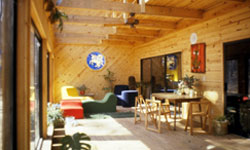
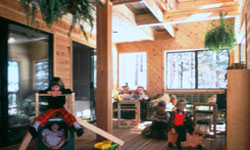
aesthetic qualities
- Space and Light – The greenhouse or solarium is a light and airy environment for people as well as plants, and offers living amenities and qualities of space and light unique in Ekose'a Homes.
It extends the visual space of adjacent rooms, making them seem larger than their dimensions might indicate. The large glass areas and tall, open spaces permit sunlight to fill the living areas. This abundance of natural light eliminates the need for most artificial lighting except at night. Even then, moonlit nights produce a unique light quality and atmosphere. During most of the day, sunlight is diffused or reflected from the interior of the greenhouse. This prevents glare as well as fading of building materials and furnishings.
Although an integral part of the air envelope, the greenhouse maintains comfortable living conditions except during the most extreme weather. Owners report that the greenhouse is actually the most popular living space in the house. On cold, sunny days, the greenhouse becomes a toasty space in which to recover from the dark and chilling effects of a long gray winter.
- Peace and Quiet – Ekose'a Homes are quiet. There is no noisy equipment associated with conventional heating and cooling and the envelope construction dampens outside noises.
- Style Flexibility – The performance of Ekose'a Homes is achieved architecturally or by the structural design. Exterior and interior styles are flexible and controllable by the owner to reflect individual desires and requirements.
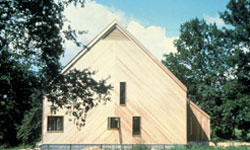
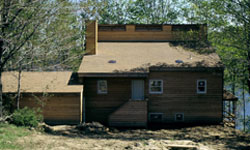
construction and costs
The cost of building an Ekose'a home is competitive with conventional designs of comparable size and quality. In fact, the actual costs of several dozen Ekose'a Homes have proven to be less than those for conventional design.
How is this possible? While there is no single or simple answer, the fact that these homes are so economical to build is certainly no accident.
Ekose'a Homes have been intentionally designed as simple rectangular boxes with simple roofs and standard details and materials throughout. Stock lumber sizes and other readily available materials are specified in all plans. Construction is monitored continuously and stock plans are revised periodically to reflect cost-effective improvements and to insure their clarity and workability. All of this helps to guarantee that Ekose’a Homes can be built at or below standard market prices.
However, keep in mind that a wide range of costs for any given design is possible, depending primarily on the amount of owner responsibility for construction, the quality of materials and exterior and interior style refinements.
In addition to initial costs, long term or life cycle costs are important considerations. The elimination of fuel, maintenance, repair and replacement costs related to conventional heating and cooling, represent a considerable savings over time to homeowners of Ekose'a Homes.
self-sufficiency
Self-sufficiency is really at the heart of the Ekose'a Homes design concept. With future energy becoming more and more expensive, Ekose'a Homes become a source of greater and greater savings in the utility bill. The future availability of energy is a concern aside from the actual costs. With Ekose'a Homes you do not have to worry about freezing during a power shortage or blackout. Security, health and comfort are the goals of this house. While the house itself does not guarantee these goals will be met, we believe that the mounting evidence provided by homeowners of Ekose’a Homes indicates that these goals become realistic and attainable.

